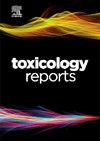In silico toxicological risk assessment of chemical constituents from Curtisia dentata stem-bark extract
Q1 Environmental Science
引用次数: 0
Abstract
Herbal products are widely used in healthcare due to their therapeutic potential. However, concerns persist among medicinal chemists and regulatory toxicologists regarding their safety and potential toxicity. Botanical products used in herbal formulations requires rigorous risk assessments. In this study, we applied in silico toxicity testing using natural flavouring complexes (NFCs) approach and Toxtree® v3.1.0 software to assess toxicological risk associated with Curtisia dentata, a widely used medicinal plant for treating diseases. We first conducted experimental analysis of the hexane crude extract of C. dentata using gas chromatography–mass spectrometry (GC-MS) to identify its chemical constituents. A total of 124 compounds were identified from GC-MS analysis and verified using reputable databases, including PubChem, Human Metabolome Database (HMDB), National Institute of Standards and Technology (NIST) database, and scientific literature. The Cramer’s toxicity class of the identified components was determined based on their congeneric groups. The identified constituents were then subjected to in silico toxicity evaluation using Toxtree® v3.1.0. Certain constituents, including aniline, 2,6-dimethoxybenzoquinone, and 1-iodododecane triggered structural alerts for genotoxic carcinogenicity and mutagenicity, while phthalic acid, 4-chloro-3-methylphenyl undecyl ester exhibited alerts for non-genotoxic carcinogenicity. While C. dentata has undoubted proven pharmacological effects, further studies should focus on confirming the in silico predictions through targeted in vitro and in vivo studies, particularly for constituents that fired multiple structural alerts.
莪术茎皮提取物化学成分的硅毒性风险评价
草药产品因其治疗潜力而广泛应用于医疗保健领域。然而,药物化学家和监管毒理学家对其安全性和潜在毒性的担忧仍然存在。在草药配方中使用的植物产品需要严格的风险评估。在本研究中,我们采用天然香料复合物(nfc)方法和Toxtree®v3.1.0软件进行了硅毒性测试,以评估齿科树(Curtisia dentata)的毒性风险。齿科树是一种广泛用于治疗疾病的药用植物。本研究首先采用气相色谱-质谱联用技术对牙牙藤己烷粗提物进行了化学成分鉴定。通过GC-MS分析共鉴定出124种化合物,并使用PubChem、人类代谢组数据库(HMDB)、美国国家标准与技术研究所(NIST)数据库和科学文献等知名数据库进行验证。所鉴定成分的克莱默毒性等级是根据它们的同属基团确定的。然后使用Toxtree®v3.1.0对鉴定的成分进行硅毒性评价。某些成分,包括苯胺、2,6-二甲氧基苯醌和1-碘十二烷触发了基因毒性致癌性和致突变性的结构警报,而邻苯二甲酸、4-氯-3-甲基苯基十一烷基酯显示了非基因毒性致癌性警报。虽然牙牙草具有毋庸置疑的药理作用,但进一步的研究应该集中在通过有针对性的体外和体内研究来证实计算机预测,特别是对于触发多个结构警报的成分。
本文章由计算机程序翻译,如有差异,请以英文原文为准。
求助全文
约1分钟内获得全文
求助全文
来源期刊

Toxicology Reports
Environmental Science-Health, Toxicology and Mutagenesis
CiteScore
7.60
自引率
0.00%
发文量
228
审稿时长
11 weeks
 求助内容:
求助内容: 应助结果提醒方式:
应助结果提醒方式:


